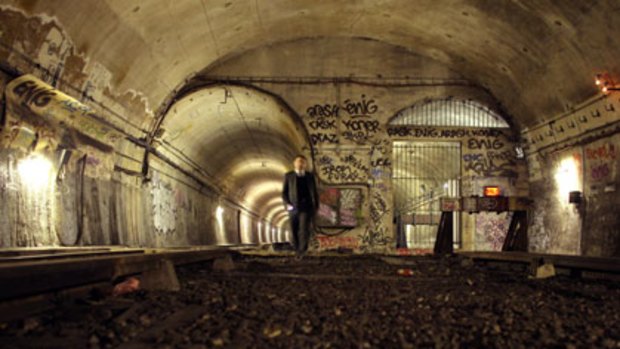
A transport employee in the tunnel linking the Porte des Lilas metro station to Haxo, one of the several "ghost" metro stations in Paris.Credit: AFP
Haxo, one of several "ghost" metro stations in Paris, was built in 1900 but rarely used. Like the others, the disused facility now attracts tourists and filmmakers captivated by their rich history.
About 10 stations in the French capital were closed after World War II due to their proximity to other stations such as the Champ de Mars near the city's landmark Eiffel Tower, or for reasons of economy.
During the war years they sheltered thousands of homeless people. The Place des Fetes and Maison Blanche stations in the working class north and south each sheltered around 2000 people every night.
They slept on the platforms, the tracks and the stairs, said Julian Pepinster, who oversees a programme aimed at preserving the rich heritage of the city's rail and underground network.
"A ventilation system was installed to filter polluted air and seven to 10 toilets were installed," he added.
But the end of the war rang the death knell for many stations.
"When the war ended, electricity was rationed and the metro ran a skeletal service. It was closed on Sunday," he said.
The ghost stations eventually drew noted directors who shot several internationally acclaimed films there, including the 2001 oeuvre Amelie - a feel-good film about a shy Parisian waitress who decides to transform the lives of others around her for the better.
Others include the 1981 cult film Diva -- a thriller tracking the love story of a postman besotted by a celebrated opera singer -- and the 2008 movie Les Femmes de l'Ombre (The Women of The Shadows) about Frenchwomen who served in the Resistance and worked as spies during World War II.
Many famous films "profited from the disused tracks of these stations," said Joel Bordes from the city's RATP transport network authority.
"However, Francois Truffaut's The Last Metro is not one of them," he said of the French director's 1980 award-winning movie set during the World War II German occupation of Paris.
The first metro line was completed in 1900 and many of the stations are renowned for their emblematic Art Nouveau entrances created by architect Hector Guimard.
Many visitors from home and abroad now re-visit the ghost facilities on foot in visits organised by the ADEMAS association, dedicated to restoring old trains and preserving the metro's history.
ADEMAS, or the Association D'Exploitation du Material Sprague, earlier organised visits on the Paris Metro's Sprague-Thomson model cars dating to the early 1900s but these were scrapped recently due to technical problems.
"The visits were until recently organised on trains constructed between 1908 and 1938 but they recently developed some technical problems," said Pepinster.
"But now there are walks organised usually on a Saturday or a Sunday. The last visit this season will take place on June 20."
Another station, Saint-Martin, has served as a refuge for homeless people with help from the Salvation Army. The people were sheltered here during the day and could consult doctors, have a haircut or take a shower.
Many tourists are drawn to the old-world feel of the disused stations: the ceramic tiled walls still lined with faded peeling posters of old French advertisements of brand names now lost with time: Olida ham and Maizena wheat.
Sign up for the Traveller Deals newsletter
Get exclusive travel deals delivered straight to your inbox. Sign up now.